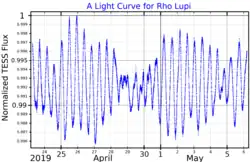Rho Lupi
Rho Lupi, Latinized from ρ Lupi, is a solitary[11] star in the southern constellation of Lupus. It is visible to the naked eye with an apparent visual magnitude of 4.05.[3] Based upon an annual parallax shift of 10.32 mas as seen from Earth, it is located about 316 light years from the Sun. It is a member of the Upper Centaurus–Lupus subgroup of the nearby Scorpius–Centaurus association.[12]
| Observation data Epoch J2000.0 Equinox J2000.0 (ICRS) | |
|---|---|
| Constellation | Lupus |
| Right ascension | 14h 37m 53.22583s[2] |
| Declination | −49° 25′ 32.9798″[2] |
| Apparent magnitude (V) | 4.05[3] |
| Characteristics | |
| Spectral type | B3/4 V[4] |
| U−B color index | −0.56[3] |
| B−V color index | −0.15[3] |
| Astrometry | |
| Radial velocity (Rv) | 8.00±7.40[5] km/s |
| Proper motion (μ) | RA: −28.26[2] mas/yr Dec.: −28.82[2] mas/yr |
| Parallax (π) | 10.32 ± 0.16 mas[2] |
| Distance | 316 ± 5 ly (97 ± 2 pc) |
| Absolute magnitude (MV) | −0.88[6] |
| Details | |
| Mass | 4.66[7] M☉ |
| Radius | 3.4[8] R☉ |
| Luminosity | 365[9] L☉ |
| Temperature | 15,947±542[7] K |
| Rotational velocity (v sin i) | 166[7] km/s |
| Age | 44[7] Myr |
| Other designations | |
| Database references | |
| SIMBAD | data |
This is a B-type main sequence star with a stellar classification of B3/4 V.[4] It is a microvariable with a period of 10.7 hours and an amplitude of 0.0046 in magnitude.[13] With an age of just 44[7] million years, the star is spinning with a projected rotational velocity of 166 km/s.[7] This is giving the star an oblate shape with an equatorial bulge that is an estimated 6% larger than the polar radius.[14] It has an estimated 4.66[7] times the mass of the Sun and about 3.4[8] times the Sun's radius. It is radiating 365[9] times the solar luminosity from its outer atmosphere at an effective temperature of 15,947 K.[7]
References
- MAST: Barbara A. Mikulski Archive for Space Telescopes, Space Telescope Science Institute, retrieved 24 September 2022.
- van Leeuwen, F. (2007), "Validation of the new Hipparcos reduction", Astronomy and Astrophysics, 474 (2): 653–664, arXiv:0708.1752, Bibcode:2007A&A...474..653V, doi:10.1051/0004-6361:20078357, S2CID 18759600.
- Johnson, H. L.; et al. (1966), "UBVRIJKL photometry of the bright stars", Communications of the Lunar and Planetary Laboratory, 4 (99): 99, Bibcode:1966CoLPL...4...99J.
- Houk, Nancy (1978), Michigan catalogue of two-dimensional spectral types for the HD stars, vol. 2, Ann Arbor: Dept. of Astronomy, University of Michigan, Bibcode:1978mcts.book.....H.
- de Bruijne, J. H. J.; Eilers, A.-C. (October 2012), "Radial velocities for the HIPPARCOS-Gaia Hundred-Thousand-Proper-Motion project", Astronomy & Astrophysics, 546: 14, arXiv:1208.3048, Bibcode:2012A&A...546A..61D, doi:10.1051/0004-6361/201219219, S2CID 59451347, A61.
- Anderson, E.; Francis, Ch. (2012), "XHIP: An extended hipparcos compilation", Astronomy Letters, 38 (5): 331, arXiv:1108.4971, Bibcode:2012AstL...38..331A, doi:10.1134/S1063773712050015, S2CID 119257644.
- David, Trevor J.; Hillenbrand, Lynne A. (2015), "The Ages of Early-Type Stars: Strömgren Photometric Methods Calibrated, Validated, Tested, and Applied to Hosts and Prospective Hosts of Directly Imaged Exoplanets", The Astrophysical Journal, 804 (2): 146, arXiv:1501.03154, Bibcode:2015ApJ...804..146D, doi:10.1088/0004-637X/804/2/146, S2CID 33401607.
- Pasinetti Fracassini, L. E.; et al. (February 2001), "Catalogue of Apparent Diameters and Absolute Radii of Stars (CADARS)", Astronomy and Astrophysics (3rd ed.), 367: 521–524, arXiv:astro-ph/0012289, Bibcode:2001A&A...367..521P, doi:10.1051/0004-6361:20000451, S2CID 425754.
- McDonald, I.; et al. (2012), "Fundamental Parameters and Infrared Excesses of Hipparcos Stars", Monthly Notices of the Royal Astronomical Society, 427 (1): 343–57, arXiv:1208.2037, Bibcode:2012MNRAS.427..343M, doi:10.1111/j.1365-2966.2012.21873.x, S2CID 118665352.
- "rho Lup". SIMBAD. Centre de données astronomiques de Strasbourg. Retrieved 2017-03-10.
{{cite web}}: CS1 maint: postscript (link) - Eggleton, P. P.; Tokovinin, A. A. (September 2008), "A catalogue of multiplicity among bright stellar systems", Monthly Notices of the Royal Astronomical Society, 389 (2): 869–879, arXiv:0806.2878, Bibcode:2008MNRAS.389..869E, doi:10.1111/j.1365-2966.2008.13596.x, S2CID 14878976.
- Chen, Christine H.; et al. (September 2012), "A Spitzer MIPS Study of 2.5-2.0 M⊙ Stars in Scorpius–Centaurus", The Astrophysical Journal, 756 (2): 24, arXiv:1207.3415, Bibcode:2012ApJ...756..133C, doi:10.1088/0004-637X/756/2/133, S2CID 119278056, 133.
- Koen, Chris; Eyer, Laurent (2002), "New periodic variables from the Hipparcos epoch photometry", Monthly Notices of the Royal Astronomical Society, 331 (1): 45–59, arXiv:astro-ph/0112194, Bibcode:2002MNRAS.331...45K, doi:10.1046/j.1365-8711.2002.05150.x, S2CID 10505995.
- Belle, G. T. (2012), "Interferometric observations of rapidly rotating stars", The Astronomy and Astrophysics Review, 20 (1): 51, arXiv:1204.2572, Bibcode:2012A&ARv..20...51V, doi:10.1007/s00159-012-0051-2, S2CID 119273474.
